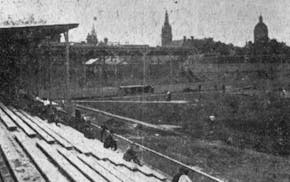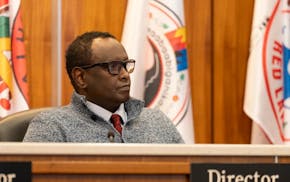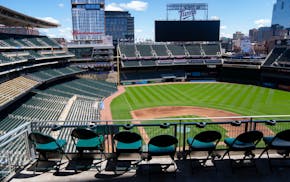When Paralyzed Veterans of America (PVA) last month awarded U.S. Bank Stadium its 2025 Barrier-Free America Award, it was the first time that an NFL stadium had received the honor.
But how do the other pro sports stadiums and arenas in the Twin Cities rate when it comes to ease of access for people with disabilities?
Pretty good, it turns out.
From wheelchair seating on multiple levels and at a range of ticket prices to on-site sensory rooms where fans on the autism spectrum can regroup and recalibrate, Minnesota's professional sports venues are increasingly adding a range of accessibility amenities.
Officials said they offer many of the same things, by design. St. Paul's Xcel Energy Center, CHS Field and Allianz Field and Minneapolis' Target Center, Target Field and U.S. Bank Stadium collaborate and communicate to one another about the latest trends in accessibility, officials said.
The result is a sports arena landscape that's more welcoming and inclusive than many other areas of the country, said Todd Kemery, a Marine Corps veteran and national director of PVA's Minnesota chapter.
"Unless you're in a wheelchair, not everybody is going to understand," he said. "But people [here] are willing to make changes. And that's all we're looking for, is to have somebody understand."
Team officials, Kemery said, "have been really excellent about listening to the community."
He and other advocates have served on committees that persuaded architects to tweak designs, widening concourses and entrance gates to ease the flow of wheelchairs and using drink rails behind disabled seating areas to keep abled-bodied people from spilling beers and popcorn on disabled fans.
That cooperation has boosted accessibility at all Twin Cities pro sports venues, said David Fenley, ADA director for the Minnesota Council on Disability. He remembers watching groups of people in wheelchairs rolling through U.S. Bank, Target Center and Allianz Field to give feedback, he said.
"All the organizations were very willing to partner, because they understand that, 'if I make this better for you, I make it better for everybody,'" Fenley said.
Here's how each stadium has addressed accessibility amenities:
U.S. Bank Stadium
The home of the Vikings exceeded Americans with Disabilities Act (ADA) requirements when it opened in July 2016, officials said. And it has added more.
Linda Hood, a local artist who was paralyzed in 2018, persuaded officials to install an adult changing station two years ago. Previously, people who are wheelchair-dependent had to be changed on restroom floors.
Working with the Minneapolis-based organization Fraser, the stadium offers a sensory room for people with autism, and sensory packs with noise-canceling headphones.
Ribbon boards display closed captioning, and a couple of sections feature American Sign Language interpreters. Listening devices tied into the public address system are handed out upon request.
U.S. Bank Stadium "sets the standard for how modern entertainment venues can ensure all fans and attendees feel valued and accommodated," Robert Thomas, PVA's national president, said in a statement.
Inclusion is not just the right thing to do, said John Drum, the stadium's general manager. It's good business.
"At the end of the day, we want people to come in and attend events and make this the economic driver that this building should be for the city, for this community, for this state," Drum said.
CHS Field
With 7,210 seats, the Lowertown home of the St. Paul Saints is much smaller than the 69,000-seat U.S. Bank Stadium. But it has many of the same accessibility features, including wheelchair and companion seating on multiple levels of the ballpark. Thanks to the involvement of Hood, it also has an adult changing table.
For years, the Saints' motto has been "Fun is good." That means it should be fun for everyone, said Sean Aronson, a team vice president. People with disabilities should feel as welcome as anyone else, he said.
"We keep an eye on what goes on at Target Center and Xcel. Like, we're all in the same business, right? And you want to find out what everybody else is doing," Aronson said.
Xcel Energy Center
Xcel Energy Center, built in 2000, has many of the same accessibility features as newer venues. But how easy are they to use if people didn't plan ahead of time to use them?
The venue's officials say they've made a point to have a number of accessibility items available "just in case," such as a stable of wheelchairs — with staff members to push them. The arena also has extra disability seats for folks who need them at the last minute, said Tracy Watson, the arena's guest experiences director.
"Let's say you bought a ticket, a regular seat, but then you [later] broke your leg. We would direct you to come along to the [Section] 105 desk," Watson said. "We take a look at where their seating is currently, because we want to try to keep it comparable. And then we would just relocate them."
People heading to a game can also ask for disability seating or wheelchair transport on the Wild's accessibility web page.
Allianz Field
It should come as no surprise that a team that built a fully inclusive playground for children outside its Midway-area stadium made sure to design that stadium to be inclusive as well.
It starts with the four main entrances, all at grade and easy to roll into, said Justin Borrell, Allianz Field's general manager. One of the latest pro teams to hit the Twin Cities market, Minnesota United wanted its doors open to all.
"Growing soccer in Minnesota is a huge component to the club growing the way it did, and that was with everybody, all fans, anybody that just wanted to come watch a soccer game," Borrell said.
The stadium even has disability seating where there is no other seating — its famed supporters' section at the stadium's south end where most fans stand, sing and chant all game long.
As at other venues, Allianz has closed captioning on ribbon boards and offers sensory kits for families who need them. It also has a wellness room for families with small children to retreat to and new mothers to nurse their babies.
"You want to deliver that product, that experience to everyone who wants it," Borrell said.
Target Center
As workers recently set up for a Katy Perry concert, David Feeley, Target Center general manager, and Ryan Gueningsman, senior guest services manager, were eager to show off the accessibility of the arena built in 1990 and renovated in 2017.
And they were quick to praise the input of Dominic Marinelli and the late Margot Imdieke Cross, disability advocates who served on an advisory committee for the renovation.
Hearing — and heeding — such perspectives is vital, they said.
"You don't just listen to a certain segment of fans. You have to listen to all fans," Feeley said. "And at the end of the day, every fan is important."
Sharing ideas has led to putting power outlets near ADA seating so people can charge battery-powered chairs. Or making sure there are enough ushers working in areas with disability seating.
"They look at your ticket, make sure people are in the right spot," he said. "It's our job to ensure you have a good experience."
Target Field
Many features of an accessible venue can be found at the home of the Twins.
ADA seating? Check. Eight hundred of Target Field's 39,000 seats are for people in wheelchairs or their companions. Sensory rooms? An adult changing table? A place for mothers to nurse their babies? Check, check and check.
Patrick Forsland started selling tickets at the inaccessible Metrodome 27 years ago. Now senior director of guest experiences at Target Field, he's immersed in making it welcoming.
"We've got a lot of newer facilities in the Twin Cities, and so I think you'll find a lot of the similar features for all the facilities," he said. "But we're very proud of what we offer here, and the fact that it's a very inclusive environment."

A history buff's quest to mark St. Paul's 'pillbox' ballpark
Prostate experts see familiar scenario in Biden's cancer diagnosis

Pushback leads Minneapolis schools to restore some funding for Latino, but not Black, student programs

Live podcast event to draw line between Minneapolis of almost 100 years ago, events of 2020

